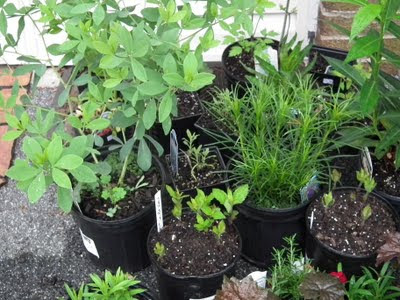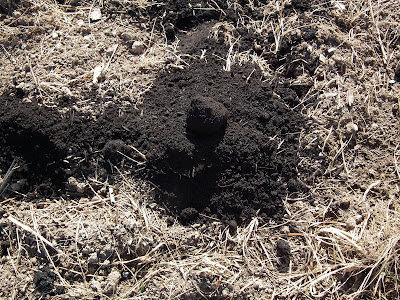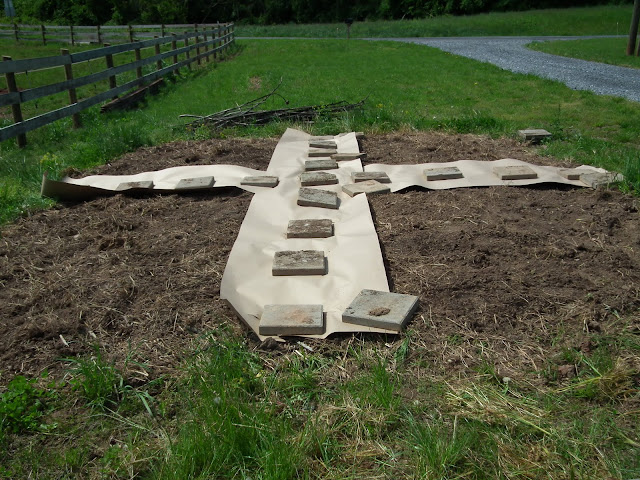 |
| Empty! |
Today I spent a lot of time preparing a 20x20 space for a native garden. I have been collecting plants for the last few weeks and I finally sat down and drew up a plan. I have to know how tall, how wide and what color these plants will be.
I want to attract native bugs, birds and butterflies. Also, the area is difficult to get water to so I thought trying natives would be a good experiment. Once they are established, they tend to be more drought resistant.
I have a few perennials that are not native, but I like them a lot.
I have them in my driveway waiting for a home:
Monarda - bee balm
Actaea - black cohosh (staying home, likes shade)
Asclepias tuberosa - butterfly weed
Baptisia - false blue indigo
Coreopsis - tickseed
Dennstaedtia - hay scented fern (staying home)
Echinacea - ruby star and purpurea
Eupatorium - joe pye weed
heuchera - coral bells -staying home
Lobelia cardinalis - cardinal flower
Osmunda - cinnamon fern - home
Penstemon
phlox - david
rudbeckia (black eyed susan)
Veronicastrum - Iron butterfly
physostegia virginiana - obedient plant
Non natives, Russian sage, zinnias,sunflowers
The best way to see pictures of these plants is to google and then choose "images" in the upper left corner. You will see a large selection of pictures.
I planted the tallest plants in the middle and the shortest in front. I added leaf grow - composted leaves to the bed and used paper mulch as a weed barrier. I have been asking for "paper, please" at the grocery store so I have enough thick paper to lay under the mulch. I am using the pavers to hold down the paper. Of course the wind picked up as soon as I started unrolling the paper mulch!
I also cut the crimson clover in one of the raised beds and dug the roots under to add nitrogen to the soil. I added an inoculant (Rhizobium bacteria) to the clover seed last fall before I planted. This process helps take nitrogen from the air and fix it into the soil. I just hate cutting down pretty plants, but the nitrogen isn't released until the plant dies.
Does everyone else start singing Crimson and Clover, Over and Over?
 |
| Will add plants in a few days - still too cold |
This is the bed I will be planting squash, peppers and some tomatoes. When the tomatoes go in, I will add a little lime to increase the calcium in the soil. This, and consistent watering will hopefully stop blossom end rot. That is when the base of the tomato flattens and turns black. Also, waiting until the soil is nice and warm and mulching helps.
 |
| example of blossom end rot |
Mother's Day. Finished the native bed. I used lots of paper as weed barrier and covered everything with the rest of the mulch we bought this spring.
Before I took these last pictures, my Son-in-law, Wesley mowed and weeded the front yard. It is starting to look so pretty. Below is a picture of a vanishing species. A young farming family.
According to the USDA, the average age of a U.S. farmer is over 55 years. Bailey and Wes are in their 20's. This is a very hard working couple!
Words of wisdom:
When you are in the country, keep your car doors closed. My sister-in- law, Lori, went to a pumpkin patch a few years ago and left her car door open while they were choosing pumpkins. A few weeks later she found a very large rat had been trapped in her car and was eating everything he could gnaw through.
When you open bags of mulch, wear gloves. My friend Doris once had a scorpion crawl out of a bag of mulch.
Now - always; I cannot stress this enough: always look before you reach for that next bag of mulch!
Welcome United Kingdom!
Before I took these last pictures, my Son-in-law, Wesley mowed and weeded the front yard. It is starting to look so pretty. Below is a picture of a vanishing species. A young farming family.
According to the USDA, the average age of a U.S. farmer is over 55 years. Bailey and Wes are in their 20's. This is a very hard working couple!
Words of wisdom:
When you are in the country, keep your car doors closed. My sister-in- law, Lori, went to a pumpkin patch a few years ago and left her car door open while they were choosing pumpkins. A few weeks later she found a very large rat had been trapped in her car and was eating everything he could gnaw through.
When you open bags of mulch, wear gloves. My friend Doris once had a scorpion crawl out of a bag of mulch.
Now - always; I cannot stress this enough: always look before you reach for that next bag of mulch!
Welcome United Kingdom!
















No comments:
Post a Comment